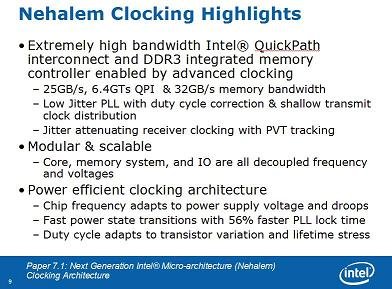
Kumar said Nehalem's QPI will deliver 25GB/s socket-to-socket bandwidth and memory bandwidth will be a whopping 32GB/s thanks to triple-channel DDR3 1333MHz memory support. That's three times as much bandwidth as AMD processors have with DDR2-800 memory in dual-channel mode.
He went on to describe the scalability of Nehalem and said all the main components (processing cores, memory and I/O) work in a decoupled fashion so each can work at a different voltage or frequency. However, unlike designs from the competition Nehalem will have synchronous interfaces for improved performance and lower latency. Intel says Nehalem's memory to cache latency will be "drastically smaller" compared to chips from the competition like AMD's Phenom.
Such that frequencies and voltages can all be set independently. The CPU core, for example, can be running at its own frequency and voltage, while the memory system is running on its own, and the I/O (Input/Output) is running on its own, and each of them can be tuned for a given segment."Another new feature in Nehalem is the improved power tuning, the chip will automatically adapt its frequency or voltage based on power draw:
Kumar said the technology itself isn't new, but that Intel's technique is different than its competitors. "The idea itself is not new but the implementation is new. So far, most people that have tried this idea have done this using what are called asynchronous interfaces which happen to be fairly slow. So the main idea is how to do all of this in a synchronous fashion with very low latency and high performance," he said.
He also described how Nehalem chips are better tuned to operate based on the level of power delivered. "Chips today run at a given frequency, at a given voltage. But we know that when running different applications the power supply keeps moving around," he said. "What we have introduced is a chip whose frequency keeps adapting every cycle to the dynamic and real time power supply it actually sees."

Some extra information about Nehalem's power saving features can be read at Bit Tech:
Intel's EIST and C1E states for clock changing to save power will now work 56 percent faster in Nehalem and the chip frequency will also adapt to power supply voltage changes and vDroop - this should make a system ever more stable, but we think it might push enthusiasts into looking for the best motherboards and PSU combinations that completely minimise this clock down effect, especially if it affects performance figures.The site also found out Nehalem's Duty Cycle adapts to transistor variation and lifetime stress, this feature will prevent CPUs from dying outright but may make them slower:
Intel even dropped an interesting titbit that it was thinking about completely decoupling itself from rated frequencies because of the constant clock changes, however it found customers and retailers were very much against this move. Despite the fact that, internally, the CPU is constantly adjusting its clock speed, from the outside it appears like a fixed frequency due to overall averaging. No doubt this continual variation will surely make our job testing hardware reliably that much more difficult though - it depends on the level of clock changes and the quality of motherboard and power supply.
Finally, Intel also mentions in its documents that the Duty Cycle adapts to transistor variation and lifetime stress - does this mean that even if your CPU isn't made as well as the next guy's, instead of dying outright it will reduce the time that part is working. Does this translate into reducing the core frequency over time?
In other words, after 12 months of overvolting and overclocking, your CPU might end up running at a lower speed you bought it at, or have less cache available as the chip turns down the use of these tired transistors? Considering CPUs die very rarely these days we can't see it being much of a problem - unless you put some silly voltages through it, that is. However, the long term implications and resellability might be of concern for some end users. We will endeavour to find out the answers from Intel.